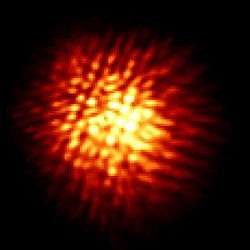R Doradus
 Infrared interferometric image of the star Credit: ESO | |
| Observation data Epoch J2000 Equinox J2000 | |
|---|---|
| Constellation | Dorado |
| Right ascension | 04h 36m 45.59127s[1] |
| Declination | −62° 04′ 37.7974″[1] |
| Apparent magnitude (V) | 4.8–6.6[2] 5.40[3] |
| Characteristics | |
| Spectral type | M8IIIe |
| Apparent magnitude (J) | −2.6[4] |
| Apparent magnitude (K) | −4.2[4] |
| U−B color index | +0.86[1] |
| B−V color index | +1.58[1] |
| Variable type | Mira variable |
| Astrometry | |
| Radial velocity (Rv) | +26.1[5] km/s |
| Proper motion (μ) | RA: −69.36[1] mas/yr Dec.: −75.78[1] mas/yr |
| Parallax (π) | 18.31 ± 0.99[1] mas |
| Distance | 178 ± 10 ly (55 ± 3 pc) |
| Details | |
| Mass | 1.2[6] M☉ |
| Radius | 370 ± 50[7] R☉ |
| Luminosity | 6,500 ± 1400[7] L☉ |
| Temperature | 2,740 ± 190[7] K |
| Rotation | 340 days |
| Other designations | |
| Database references | |
| SIMBAD | data |
R Doradus[8] (HD 29712[8] or P Doradus[8]) is the name of a red giant Mira variable star in the far-southern constellation Dorado, although visually it appears more closely associated with the constellation Reticulum. Its distance from Earth is 178 ± 10 light-years (54.6 ± 3.1 parsecs).[1] Having a uniform disk diameter of 0.057 ± 0.005 arcsec,[9] it is currently believed to be the star with the largest apparent size as viewed from Earth (not counting the Sun). The estimated diameter of R Doradus is 515 ± 70 million km (3.46 AU) or 370 ± 50[7] times the diameter of the Sun. If placed at the centre of the Solar System, the orbit of Mars and most of the main asteroid belt would be contained within the star.
The visible magnitude of R Doradus varies between 4.8 and 6.6, which makes it usually just visible to the naked eye, but in the infrared it is one of the brightest stars in the sky and its bolometric luminosity is 6500 ± 1400 times that of the Sun.[10] With a near-infrared J band magnitude of −2.6,[4] only Betelgeuse at −2.9 is brighter.
References
- 1 2 3 4 5 6 7 8 van Leeuwen, F. (November 2007), "Validation of the new Hipparcos reduction", Astronomy and Astrophysics, 474 (2): 653–664, arXiv:0708.1752
 , Bibcode:2007A&A...474..653V, doi:10.1051/0004-6361:20078357
, Bibcode:2007A&A...474..653V, doi:10.1051/0004-6361:20078357 - ↑ "GCVS Query=R Dor". General Catalogue of Variable Stars @ Sternberg Astronomical Institute, Moscow, Russia. Retrieved 2012-08-22.
- ↑ Nicolet, B. (1978). "Photoelectric photometric Catalogue of homogeneous measurements in the UBV System". Astronomy and Astrophysics Supplement Series. 34: 1–49. Bibcode:1978A&AS...34....1N.
- 1 2 3 Skrutskie, M. F.; Cutri, R. M.; Stiening, R.; Weinberg, M. D.; Schneider, S.; Carpenter, J. M.; Beichman, C.; Capps, R.; Chester, T.; Elias, J.; Huchra, J.; Liebert, J.; Lonsdale, C.; Monet, D. G.; Price, S.; Seitzer, P.; Jarrett, T.; Kirkpatrick, J. D.; Gizis, J. E.; Howard, E.; Evans, T.; Fowler, J.; Fullmer, L.; Hurt, R.; Light, R.; Kopan, E. L.; Marsh, K. A.; McCallon, H. L.; Tam, R.; Van Dyk, S. (2006). "The Two Micron All Sky Survey (2MASS)". The Astronomical Journal. 131 (2): 1163. Bibcode:2006AJ....131.1163S. doi:10.1086/498708.
- ↑ Wilson, Ralph Elmer (1953). General Catalogue of Stellar Radial Velocities. Washington: Carnegie Institution of Washington. Bibcode:1953GCRV..C......0W.
- ↑ Jacob, A. P.; et al. (March 2004), "Multiwavelength visibility measurements of Miras: observations of R Dor and R Leo with MAPPIT", Monthly Notices of the Royal Astronomical Society, 349 (1): 303–312, Bibcode:2004MNRAS.349..303J, doi:10.1111/j.1365-2966.2004.07503.x
- 1 2 3 4 Bedding, T. R.; et al. (April 1997), "The angular diameter of R Doradus: a nearby Mira-like star", Monthly Notices of the Royal Astronomical Society, 286 (4): 957–962, arXiv:astro-ph/9701021
 , Bibcode:1997MNRAS.286..957B, doi:10.1093/mnras/286.4.957
, Bibcode:1997MNRAS.286..957B, doi:10.1093/mnras/286.4.957 - 1 2 3 "* P Dor". SIMBAD. Centre de données astronomiques de Strasbourg. Retrieved 2015-03-05.
- ↑ Richichi, A.; Percheron, I.; Khristoforova, M. (February 2005), "CHARM2: An updated Catalog of High Angular Resolution Measurements", Astronomy and Astrophysics, 431 (2): 773–777, Bibcode:2005A&A...431..773R, doi:10.1051/0004-6361:20042039
- ↑ "The Biggest Star in the Sky" (Press release). European Southern Observatory. 1997-03-11. Archived from the original on May 21, 2008. Retrieved 2006-09-05.
External links
- Swinburne Astronomy Online; information about R Doradus
- Variáveis Binoculares
- The 3µ spectrum of R Doradus observed with the ISO-SWS